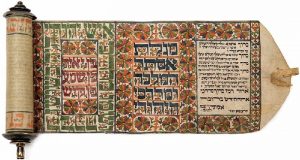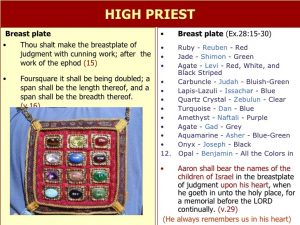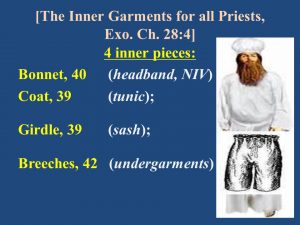Tetzaveh Purim 2021 – The Underwear of the Priests
by devadmin | February 25, 2021 9:20 pm
 Raboyseyee and Ladies,
Raboyseyee and Ladies,
Ershtens, a freylichin Purim which this year, and in many others -but not all- mamish coincides with Parshas Tetzaveh. What do they have in common? Fashion! The heylige Toirah is fashion focused? Read this week’s parsha and be forever convinced. Kimat the entire parsha is dedicated to the fashioning of a designer line of clothing to be worn by the kohanim; rank and file, and the koihen godol. Not just was the RBSO intimately involved with the planning and building of His house, the Mishkan and its accoutrements (so to speak), He was also quite particular on what people must wear when entering.
 Says the urban dictionary, azoy: a fashionista is a designer, promoter, or follower of the latest fashions. Says Merriam Webster and who codified the dictionary, azoy: A person devoted to fashion clothing, particularly unique or high fashion may be referred to as a fashionista. As an aside, for decades I used to wonder if Merriam was a he or a she. So happens that the dictionary was written by Noah Webster and the question is azoy: who was Merriam and why do he/she get a title named credit. The bottom line. Curious as I was, and much to my surprise I found this tidbit of information: In 1831, George and Charles Merriam founded the company as G & C Merriam Co. in Springfield, Massachusetts. In 1843, after Noah Webster died, the company bought the rights to An American Dictionary of the English Language from Webster’s estate. All Merriam-Webster dictionaries trace their lineage back to this source. The bottom line: Merriam, a female sounding name, was but the last name of a male who added his name to Webster’s body of work. Money talks! Veyter.
Says the urban dictionary, azoy: a fashionista is a designer, promoter, or follower of the latest fashions. Says Merriam Webster and who codified the dictionary, azoy: A person devoted to fashion clothing, particularly unique or high fashion may be referred to as a fashionista. As an aside, for decades I used to wonder if Merriam was a he or a she. So happens that the dictionary was written by Noah Webster and the question is azoy: who was Merriam and why do he/she get a title named credit. The bottom line. Curious as I was, and much to my surprise I found this tidbit of information: In 1831, George and Charles Merriam founded the company as G & C Merriam Co. in Springfield, Massachusetts. In 1843, after Noah Webster died, the company bought the rights to An American Dictionary of the English Language from Webster’s estate. All Merriam-Webster dictionaries trace their lineage back to this source. The bottom line: Merriam, a female sounding name, was but the last name of a male who added his name to Webster’s body of work. Money talks! Veyter.
 Those with a nose for fashion, mistama mistakenly believe that Vogue, arguably the most influential fashion magazine in the world, which has been setting fashion standards for over a century and is the top-selling fashion magazine in the world with editions globally, was the first to focus on women’s fashion. Ober the Ois is here to set the record straight: mamish back in 1672, under the reign of Louis XIV in France, the term “fashion magazine” made its initial emergence with the publication of Mercure Galant which featured illustrated fashion plates of what the aristocracy was wearing. And what about men’s fashion? Esquire, the second oldest of the men’s magazines, was founded in 1933, and GQ (formerly Gentlemen’s Quarterly) was founded back in 1931. GQ focuses on fashion, style, and culture for men, articles on food, movies, fitness, sex avada, music, travel, sports, technology, and books are also featured. The bottom line: all topics covered are designed to increase your chances of getting more sex.
Those with a nose for fashion, mistama mistakenly believe that Vogue, arguably the most influential fashion magazine in the world, which has been setting fashion standards for over a century and is the top-selling fashion magazine in the world with editions globally, was the first to focus on women’s fashion. Ober the Ois is here to set the record straight: mamish back in 1672, under the reign of Louis XIV in France, the term “fashion magazine” made its initial emergence with the publication of Mercure Galant which featured illustrated fashion plates of what the aristocracy was wearing. And what about men’s fashion? Esquire, the second oldest of the men’s magazines, was founded in 1933, and GQ (formerly Gentlemen’s Quarterly) was founded back in 1931. GQ focuses on fashion, style, and culture for men, articles on food, movies, fitness, sex avada, music, travel, sports, technology, and books are also featured. The bottom line: all topics covered are designed to increase your chances of getting more sex.
 And we lead this week’s review of Parshas Tetzaveh which coincides with Purim and Shushan Purim because -as mentioned above- both prominently feature clothing and fashion. Accordingly, the heylige Ois will weave in and out of the Migillah and the parsha. And while it’s zicher the case that Migillahs Esther, whose bottom line is that Queen Esther saved the Jewish people when she reached out and touched the king’s royal scepter and proving once and for all just how vichtig it is for all wives, and avada Jewish one’s, to learn this lesson, if you chap, clothing too feature prominently as we shall soon discover. The bottom line: special clothing and reaching out to touch the royal scepter, may have saved her marriage and her people. Shoin! Over in our parsha of the week, where clothing seemingly made the man -assuming that man was a koihen or the koihen godol (high priest), clothing seemingly may also have saved the lives of those instructed to don them. The wrong outfit could kill! Mamish!
And we lead this week’s review of Parshas Tetzaveh which coincides with Purim and Shushan Purim because -as mentioned above- both prominently feature clothing and fashion. Accordingly, the heylige Ois will weave in and out of the Migillah and the parsha. And while it’s zicher the case that Migillahs Esther, whose bottom line is that Queen Esther saved the Jewish people when she reached out and touched the king’s royal scepter and proving once and for all just how vichtig it is for all wives, and avada Jewish one’s, to learn this lesson, if you chap, clothing too feature prominently as we shall soon discover. The bottom line: special clothing and reaching out to touch the royal scepter, may have saved her marriage and her people. Shoin! Over in our parsha of the week, where clothing seemingly made the man -assuming that man was a koihen or the koihen godol (high priest), clothing seemingly may also have saved the lives of those instructed to don them. The wrong outfit could kill! Mamish!
Another bottom line: sections of both the Migillah, being read just about now or soon in most shuls, and the parsha, read more like a fashion magazine than a typical parsha in the RBSO’s heylige Toirah. What’s pshat? The good news: unlike various monthly fashion-oriented magazines, the heylige Toirah was free-gifted to the Yiddin by the RBSO back a few parshas. The bad news: we still spend a not so small sized fortune in tuition monies making sure that the free gift is taught to our kids; what’s pshat? In Tetzaveh, we get detailed and colorful accounts of the garments to be worn by the Koihen Gadol, and the other Kohanim.
 The focus is on Aharoin, who is to become the High Priest of the soon-to-be-built Mishkan (Holy Tabernacle). The Yiddin are commanded to give Aharoin “bigdei koidesh” (holy clothing), for the sake of dignity and adornment (Shmois 28:2). These sacred garments were to be crafted by skilled artisans and included a breastplate, a robe, a fringed tunic, a headdress, a sash, and an “eyphoid” — which Rashi translates as a sort of fancy apron. Each garment is colorfully described in all of its particulars: its gold, blue, purple and crimson yarns, its fine linen, its “braided chains of corded work in pure gold”. It is clear that these are not simple frocks. Grada as the Ois reads the detailed dress code so soon after redemption from slavery, he is reminded and encouraged of how quickly life can change. Mamish weeks ago, the Yiddin were still slaves -locked up- so to speak- and shoin, in an instant, life has turned upside down (think Purim) and they have become unshackled from their past troubles. They were now ready to build a new structure and focus on fancy clothing. The bottom line: it can happen to anyone facing serious crises.
The focus is on Aharoin, who is to become the High Priest of the soon-to-be-built Mishkan (Holy Tabernacle). The Yiddin are commanded to give Aharoin “bigdei koidesh” (holy clothing), for the sake of dignity and adornment (Shmois 28:2). These sacred garments were to be crafted by skilled artisans and included a breastplate, a robe, a fringed tunic, a headdress, a sash, and an “eyphoid” — which Rashi translates as a sort of fancy apron. Each garment is colorfully described in all of its particulars: its gold, blue, purple and crimson yarns, its fine linen, its “braided chains of corded work in pure gold”. It is clear that these are not simple frocks. Grada as the Ois reads the detailed dress code so soon after redemption from slavery, he is reminded and encouraged of how quickly life can change. Mamish weeks ago, the Yiddin were still slaves -locked up- so to speak- and shoin, in an instant, life has turned upside down (think Purim) and they have become unshackled from their past troubles. They were now ready to build a new structure and focus on fancy clothing. The bottom line: it can happen to anyone facing serious crises.
 The Koihen Gadol is commanded to wear eight clothing items, each of which are custom-designed for his work in the Mishkan. Just by way of example, the Choishen (the breastplate), was to contain twelve gemstones, each engraved with the name of a sheyvet (tribe) of the Bnai Yisrael. Vus epes (why)? Says the medrish (Shmois Rabbah) that the reason the stones were placed in the Choishen was so that the RBSO would see them when Aharoin entered to perform the RBSO’s service. That’s logical ober listen to this. According to the medrish, the stones would serve as a reminder to the RBSO of the merits of the shvotim (tribes). They had merits? Last I read and as discussed, a good number of them (all but one) were complicit in the prearranged plot to kill and then sell their own brother Yoisef into slavery; were they not? And let us not forget the 22- year coverup. A few committed other sins, did they not? They did! One, let’s not name him, was excoriated by his father Yaakov -mamish on his deathbed- for bedding one of his wives. Did they ever repent for these grievous sins? That’s of course a machloikes, ober avada there is good news to be gleamed from the fact that the RBSO wanted to see the stones and be reminded of them. Seemingly He forgave them and moved on; we should all be so lucky.
The Koihen Gadol is commanded to wear eight clothing items, each of which are custom-designed for his work in the Mishkan. Just by way of example, the Choishen (the breastplate), was to contain twelve gemstones, each engraved with the name of a sheyvet (tribe) of the Bnai Yisrael. Vus epes (why)? Says the medrish (Shmois Rabbah) that the reason the stones were placed in the Choishen was so that the RBSO would see them when Aharoin entered to perform the RBSO’s service. That’s logical ober listen to this. According to the medrish, the stones would serve as a reminder to the RBSO of the merits of the shvotim (tribes). They had merits? Last I read and as discussed, a good number of them (all but one) were complicit in the prearranged plot to kill and then sell their own brother Yoisef into slavery; were they not? And let us not forget the 22- year coverup. A few committed other sins, did they not? They did! One, let’s not name him, was excoriated by his father Yaakov -mamish on his deathbed- for bedding one of his wives. Did they ever repent for these grievous sins? That’s of course a machloikes, ober avada there is good news to be gleamed from the fact that the RBSO wanted to see the stones and be reminded of them. Seemingly He forgave them and moved on; we should all be so lucky.
Ober what have the garments of the koihen godol worn in the Mishkan and later in the Beis Hamikdash have to do with Purim? With Queen Esther? Or efsher even with her predecessor, Vashti, she the rebellious and intransigent queen who refused her husband’s subpoena to appear efsher with clothing and efsher naked mamish, depending on which medrish talks to you. Let’s find out in this most gishmak pshat which ties all this together mamish so beautifully.
Says the heylige Toirah (Shmois 28:4), azoy: These are the vestments they shall make: a breastplate, an ephod, a robe, a coat, a turban, and a sash.” There are also a headplate or tzitz, and pants, mentioned elsewhere. And the question is azoy: When the Yiddin went into exile, when the Beis Hamikdash (Temple) was destroyed, the very one(s) we mourn over each Tisha Be’av, what became of these wonderful garments? Were they too destroyed? Burned in the raging fire?
Ober says the medrish (Esther Rabbah) mamish so gishmak azoy: during their famous parties in Shushan as described very early in the Migillah, king Ach-ash-vey-roish (Ahasuerus for the goyim and not orthodox readers), and Vashti wore the garments of the Koihen Godol (high priest), garments that had been pilfered and carried off during the attack on the Temple in Jerusalem. You hear this raboyseyee? Aside from other vessels (and as another aside, many believe that certain vessels, the heylige menorah specifically, are still to be found in the Catacombs of the Vatican), garments from Yirusholayim made their way over to Shushan and the King’s palace? And that Achashveyroish and Vashti were dressed in them? A female wearing clothing designed for a man? No wonder she deserved death! This medrish gives the royal parties of the Persian empire a sinister cast: to make a claim that the king and queen were not merely decadent, but also sacrilegious, say it’s not so. Ober the medrish, ever concerned with the issue of fairness within the text, and not particularly sympathetic to the independent-minded queen, sets that up as a reason why Vashti deserved her fate: she had the gall to wear the garments of the high priest. Yikes! The medrish mamish cleverly connects our parsha, which describes in detail, the garments of the koihen godol, with the story of Purim, which is always read in close proximity to Parshas Tetzaveh. Another medrish tells us that the near tragic events of the Megillah were a direct result of the Yiddin’s r near total assimilation into Persian society, as reflected by their masochistic willingness to partake in Achashveyroish’s dinner served on vessels taken from the Beis Hamikdash; oy vey!
Ober was Vashti the only one in the Purim story to don priestly clothing? Another medrish has Achashveyroish asking Vashti to appear sans clothing. Mamish? Let’s recall that the Migilla opens with a massive all-male drinking party at the King’s palace, then cuts to an all-female drinking party at the queen’s palace. Disaster strikes when the king demands that Queen Vashti switch parties while “wearing the crown of royalty, so as to show the nations and the officers her beauty”. Says the medrish (there are myriad versions of what went down and who in this story), azoy: she was ordered to come wearing only the crown. In other words: butt naked. Seemingly there was more than one way to show off the royal jewels. The medrish continues and tells us that Vashti refused, and the king banished her and removed her queenship. In plain English: he had her killed.
And what about Esther? What was she wearing? Was she efsher also connected to priestly clothing? Says the Migillah azoy: When Esther goes in to the king, unbidden, to attempt to save her people, the text explicitly reports: vatilbash Esther malchus (Esther dressed in royal garments), or more literally, Esther dressed in royalty. What is the nature of this regal dress? Nu, we have to imagine that Esther dressed in a particularly magnificent outfit in order to get his attention. Her plan: for the king to find her beautiful and irresistible. Ober, let’s read this shtikel Gemora which says azoy (Megillah 14b): “Esther was clothed in the holy spirit.” Esther entered the king’s presence garbed in something more ethereal than ermine or velvet. And the bottom line? Is there a connection between Esther and the Koihen Godol? Let’s discuss the parallel between Esther at the king’s court and the high priest in the Holy of Holies on Yom Kippur. Esther must enter the king’s innermost chamber even though she may perish. The high priest also must enter the RBSO’s innermost chamber, even though this is perilous. It’s especially perilous if he’s not decked out in full uniform as commanded in our parsha and the punishment may be instant death. Both Esther and the koihen godol must dress in especially magnificent garments for this event. Both Esther and the high priest must fast in order to prepare for their ordeals. Both Esther and the high priest must stand in a courtyard before passing into the chamber they must enter. Both Esther and the high priest make this journey to the inner place in order to plead for the safety of the Yiddin, and both of them emerge triumphant, having obtained rescue for their people. Mamish gishmak.
Did Esther take on the role of high priest, becoming the guardian of her people? Over in the Purim story with the Yiddin living in golus (exile), without a holy temple and without the ability for the koihen gadol to perform rituals of repentance, did Esther become the source of deliverance and atonement? Seemingly so; she appeared before the king clothed in her own regal garments, but efsher symbolically she went to the king in the garments of the high priest. Outlandish? Efsher not; let’s read this shtikel from the heylige Zoihar (Tikunei Zohar 57b) who makes Esther’s role as high priest explicit, saying azoy: At that time, Esther beautified herself with clothing of atonement, and this is what is meant by the verse: vatilbash Esther malchus. With these garments she was able to go into the inner chamber. “She stood in the inner chamber of the King… she found favor in his eyes.” The secret of these words is that the RBSO saw her and remembered the eternal covenant. The RBSO heard her, forgave her, and responded. The bottom line: in the story of Purim, everything was taka upside down. Esther dressed up in clothing of royalty while playing the part of high priest.
Shoin, let’s close out this section with a vort from the Mei haShiloach (Rabbi Mordechai Yosef Lainier of Ishbitz), who said azoy: we too have the opportunity to wear the high priest’s garments (metaphorically avada) each morning as we daven. In the blessing Ahavah Rabbah just before the shemah prayer, there is a mantra-like repetition of verbs: lehovin ulehaskel lishmoia lilmoid ulelamed lishmoir vela’asois ulekayem…to understand, to discern, to hear, to learn, to teach, to guard, to do, and to uphold (the teachings of the RBSO’s heylige Toirah). These eight words, he suggests, refer to the eight priestly garments:
Lehovin: to understand the sash (avnet)
Lehaskel: to discern the breastplate (choishen)
Lishmoia: to hear the robe (me’il)
Lilmoid: to learn the turban (mitznefes)
Lelamed: to teach the headplate (tzitz)
Lishmoir: to guard the coat (kesoines)
V’lLa’asois: to do the eiphoid
Ulekayem: to sustain the pants (mikhnasayim)
Shoin, we close out this 2021 Parsha/Migillah combo with the following. The first 40 pisukim of the clothing instructions (Shmois 28:1-40) provide details of every article of clothing to be worn by the rank and file kohanim and the high priest. Then we get to pisukim 41 -43 where we read these new instructions.
וְהִלְבַּשְׁתָּ֤ אֹתָם֙ אֶת־אַהֲרֹ֣ן אָחִ֔יךָ וְאֶת־בָּנָ֖יו אִתּ֑וֹ וּמָשַׁחְתָּ֨ אֹתָ֜ם וּמִלֵּאתָ֧ אֶת־יָדָ֛ם וְקִדַּשְׁתָּ֥ אֹתָ֖ם וְכִהֲנ֥וּ לִֽי׃
Put these on your brother Aaron and on his sons as well; anoint them, and ordain them and consecrate them to serve Me as priests.
וַעֲשֵׂ֤ה לָהֶם֙ מִכְנְסֵי־בָ֔ד לְכַסּ֖וֹת בְּשַׂ֣ר עֶרְוָ֑ה מִמָּתְנַ֥יִם וְעַד־יְרֵכַ֖יִם יִהְיֽוּ׃
You shall also make for them linen breeches to cover their nakedness; they shall extend from the hips to the thighs.
וְהָיוּ֩ עַל־אַהֲרֹ֨ן וְעַל־בָּנָ֜יו בְּבֹאָ֣ם ׀ אֶל־אֹ֣הֶל מוֹעֵ֗ד א֣וֹ בְגִשְׁתָּ֤ם אֶל־הַמִּזְבֵּ֙חַ֙ לְשָׁרֵ֣ת בַּקֹּ֔דֶשׁ וְלֹא־יִשְׂא֥וּ עָוֺ֖ן וָמֵ֑תוּ חֻקַּ֥ת עוֹלָ֛ם ל֖וֹ וּלְזַרְע֥וֹ אַחֲרָֽיו׃ (ס)
They shall be worn by Aaron and his sons when they enter the Tent of Meeting or when they approach the altar to officiate in the sanctuary, so that they do not incur punishment and die. It shall be a law for all time for him and for his offspring to come.

And the question that mamish arose and was argued over is azoy: in posik 41 Moishe is given a direct order from the RBSO to “put these on your brother.” Moishe is to mamish dress Aharoin up in his clothing and other vestments. And the question? Was Moishe also supposed to dress his brother Aharoin in his underwear? What’s pshat? Let’s re-read posik 42 where Moishe is instructed to fashion “breeches to cover their nakedness.” In other words: kotchkis, intehoizen (underwear). Was Aharoin to put this item on by himself? Or, was Moishe to put those on him as well? Though it’s taka Purim tonight and tomorrow, and you might be thinking this underwear questions falls into the category of Purim Toirah, believe it or not, this question was hotly debated between Rashi and The Ohr Ha’chaim and one other. We imagine that Moishe and Aharoin too had some discussion over the instructions. Says Rashi azoy: the commandment in posik 41 for Moishe to clothe Aharoin and his sons, included all the priestly garments. Moishe alone was to dress the naked kohanim from top to bottom. Or, efsher more accurately started, from, bottom to top. Ober says the Ohr Hachaim that it’s not so! Aharoin was supposed to put on his own underwear or breeches to cover his nakedness. What’s the argument over? It’s azoy: it’s only in posik 42 where the instructions are given to fashion underwear, ober the instructions to dress Aharoin were given in 41. Shoin, and if that’s the case, Moishe was only supposed to dress Aharoin in the clothing detailed in pisukim 1-40. Accordingly, Aharoin was to put on his own underwear. Or, do the instructions to make underwear to cover their nakedness -though given one posik later, also included in Moishe’s instructions to dress them? Moreover, says the Levush Ha’ohroh azoy: the mitzius (facts on the ground) is that Aharoin put on his own gotchkis. Why so? Because it would be immodest for Moishe to put on his brother’s underwear to cover his nakedness when Aharoin was perfectly capable of putting these on himself. Shoin! The case of the underwear to cover nakedness is thankfully resolved. Is it? Maybe not. And why not? Because Moishe was also instructed and required to immerse the koihanim in water (mikveh style) while they were totally undressed (naked mamish), so dressing them in their breeches after the ritual purification would hardly represent a compromise of whatever modesty standards were then in place for post mikveh activities. And the bottom line? did Moishe dress them in all their garments, underwear included? Or, did Aharoin put his own breeches on and then Moishe did the rest? Ver veyst? The bottom line: only priests were -maybe- to have their underwear put on for them. In hyntige tzeytin (in today’s times) everyone should avada put on and take off their own underwear. If your children ever tell you that their rebbe or camp counselor offered to put to demonstrate how Moishe dressed the kohanim, call someone immediately.
Happy Purim and a gittin Shabbis!
The Heylige Oisvorfer Ruv
Yitz Grossman
Source URL: https://oisvorfer.com/tetzaveh-purim-2021-the-underwear-of-the-priests/